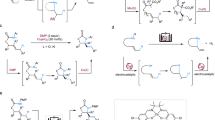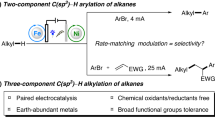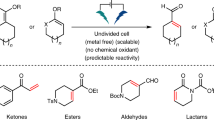Abstract
New methods and strategies for the direct functionalization of C–H bonds are beginning to reshape the field of retrosynthetic analysis, affecting the synthesis of natural products, medicines and materials1. The oxidation of allylic systems has played a prominent role in this context as possibly the most widely applied C–H functionalization, owing to the utility of enones and allylic alcohols as versatile intermediates, and their prevalence in natural and unnatural materials2. Allylic oxidations have featured in hundreds of syntheses, including some natural product syntheses regarded as “classics”3. Despite many attempts to improve the efficiency and practicality of this transformation, the majority of conditions still use highly toxic reagents (based around toxic elements such as chromium or selenium) or expensive catalysts (such as palladium or rhodium)2. These requirements are problematic in industrial settings; currently, no scalable and sustainable solution to allylic oxidation exists. This oxidation strategy is therefore rarely used for large-scale synthetic applications, limiting the adoption of this retrosynthetic strategy by industrial scientists. Here we describe an electrochemical C–H oxidation strategy that exhibits broad substrate scope, operational simplicity and high chemoselectivity. It uses inexpensive and readily available materials, and represents a scalable allylic C–H oxidation (demonstrated on 100 grams), enabling the adoption of this C–H oxidation strategy in large-scale industrial settings without substantial environmental impact.
This is a preview of subscription content, access via your institution
Access options
Subscribe to this journal
Receive 51 print issues and online access
$199.00 per year
only $3.90 per issue
Buy this article
- Purchase on Springer Link
- Instant access to full article PDF
Prices may be subject to local taxes which are calculated during checkout





Similar content being viewed by others
References
Gutekunst, W. R. & Baran, P. S. C–H functionalization logic in total synthesis. Chem. Soc. Rev. 40, 1976–1991 (2011)
Weidmann, V. & Maison, W. Allylic oxidations of olefins to enones. Synthesis 45, 2201–2221 (2013)
Nakamura, A. & Nakada, M. Allylic oxidations in natural product synthesis. Synthesis 45, 1421–1451 (2013)
Sequeira, C. A. C. & Santos, D. M. F. Electrochemical routes for industrial synthesis. J. Braz. Chem. Soc. 20, 387–406 (2009)
Degner, D. in Electrochemistry III (ed. Steckchan, E. ) 1–95 (Springer, 1988)
Moeller, K. D. Synthetic applications of anodic electrochemistry. Tetrahedron 56, 9527–9554 (2000)
Sperry, J. B. & Wright, D. L. The application of cathodic reductions and anodic oxidations in the synthesis of complex molecules. Chem. Soc. Rev. 35, 605–621 (2006)
Yoshida, J.-i., Kataoka, K., Horcajada, R. & Nagaki, A. Modern strategies in electroorganic synthesis. Chem. Rev. 108, 2265–2299 (2008)
Francke, R. & Little, R. D. Redox catalysis in organic electrosynthesis: basic principles and recent developments. Chem. Soc. Rev. 43, 2492–2521 (2014)
Gütz, C., Bänziger, M., Bucher, C., Galvão, T. R. & Waldvogel, S. R. Development and scale-up of the electrochemical dehalogenation for the synthesis of a key intermediate for NS5A inhibitors. Org. Process Res. Dev. 19, 1428–1433 (2015)
Shono, T. & Kosaka, T. Organic synthesis by electrolysis III anodic allylic substitution. Tetrahedr. Lett. 9, 6207–6208 (1968)
Shono, T. & Ikeda, A. Electroorganic chemistry X anodic allylic substitution. J. Am. Chem. Soc. 94, 7892–7898 (1972)
Masui, M., Hara, S., Ueshima, T., Kawaguchi, T. & Ozaki, S. Anodic oxidation of compounds having benzylic or allylic carbon and α-carbon to hetero atom using N-hydroxyphthalimide as a mediator. Chem. Pharm. Bull. 31, 4209–4211 (1983)
Masui, M., Hosomi, K., Tsuchida, K. & Ozaki, S. Electrochemical oxidations of olefins using N-hydroxyphthalimide as a mediator. Chem. Pharm. Bull. 33, 4798–4802 (1985)
Ueda, C., Noyama, M., Ohmori, H. & Masui, M. Reactivity of phthalimide-N-oxyl: a kinetic study. Chem. Pharm. Bull. 35, 1372–1377 (1987)
Foricher, J., Fürbringer, C. & Pfoertner, K. Process for the catalytic oxidation of isoprenoids having allylic groups. US patent 5,030,739 (1991)
Ishii, Y. et al. A novel catalysis of N-hydroxyphthalimide in the oxidation of organic substrates by molecular oxygen. J. Org. Chem. 60, 3934–3935 (1995)
Recupero, F. & Punta, C. Free radical functionalization of organic compounds catalyzed by N-hydroxyphthalimide. Chem. Rev. 107, 3800–3842 (2007)
Miller, R. A., Li, W. & Humphrey, G. R. A ruthenium catalyzed oxidation of steroidal alkenes to enones. Tetrahedr. Lett. 37, 3429–3432 (1996)
Harre, M. et al. Some reaction safety aspects of ruthenium-catalyzed allylic oxidations of ∆-5-steroids in the pilot plant. Org. Process Res. Dev. 2, 100–104 (1998)
Campbell, A. N. & Stahl, S. S. Overcoming the ‘oxidant problem’: strategies to use O2 as the oxidant in organometallic C–H oxidation reactions catalyzed by Pd (and Cu). Acc. Chem. Res. 45, 851–863 (2012)
Osterberg, P. M. et al. Experimental limiting oxygen concentrations for nine organic solvents at temperatures and pressures relevant to aerobic oxidations in the pharmaceutical industry. Org. Process Res. Dev. 19, 1537–1543 (2015)
Mudryk, B., Zheng, B., Chen, K. & Eastgate, M. D. Development of a robust process for the preparation of high-quality dicyclopropylamine hydrochloride. Org. Process Res. Dev. 18, 520–527 (2014)
Cai, Y., Koshino, N., Saha, B. & Espenson, J. H. Kinetics of self-decomposition and hydrogen atom transfer reactions of substitute phthalimide N-oxyl radicals in acetic acid. J. Org. Chem. 70, 238–243 (2005)
Modzelewska, A., Sur, S., Kumar, S. K. & Khan, S. R. Sesquiterpenes: natural products that decrease cancer growth. Curr. Med. Chem. Anticancer Agents 5, 477–499 (2005)
Michaudel, Q. et al. Improving physical properties via C–H oxidation: chemical and enzymatic approaches. Angew. Chem. Int. Ed. 53, 12091–12096 (2014)
Marwah, P. & Lardy, H. A. Process for effecting allylic oxidation using dicarboxylic acid imides and chromium reagents. US patent 6,384,251 (2002)
Anastas, P. T. & Warner, J. C. Green Chemistry: Theory and Practice (Oxford Univ. Press, 1998)
Frey, D. A., Wu, N. & Moeller, K. D. Anodic electrochemistry and the use of a 6-volt lantern battery: a simple method for attempting electrochemically based synthetic transformations. Tetrahedr. Lett. 37, 8317–8320 (1996)
Frankowski, K. J., Liu, R., Milligan, G. L., Moeller, K. D. & Aubé, J. Practical electrochemical anodic oxidation of polycyclic lactams for late stage functionalization. Angew. Chem. Int. Ed. 54, 10555–10558 (2015)
Acknowledgements
This work was supported by an NSF predoctoral fellowship (B.R.R.), National Institute of General Medical Sciences grant GM-097444, Asymchem and Bristol–Myers Squibb. We thank D.-H. Huang and L. Pasternack for assistance with NMR spectroscopy; A. L. Rheingold, C. E. Moore and M. A. Galella for X-ray crystallographic analysis; and D. G. Blackmond, O. Luca, T. Paschkewitz, Y. Ishihara and T. Razler for discussions.
Author information
Authors and Affiliations
Contributions
E.J.H., B.R.R. and P.S.B. conceived this work; E.J.H., B.R.R., K.C., M.D.E. and P.S.B. designed the experiments; E.J.H. and B.R.R. conducted the experiments and analysed the data; Y.C. and J.T. performed the large-scale experiments; E.J.H., B.R.R., K.C., M.D.E. and P.S.B. wrote the manuscript.
Corresponding author
Ethics declarations
Competing interests
The authors declare no competing financial interests.
Additional information
Metrical parameters for the structure of 24 are available free of charge from the Cambridge Crystallographic Data Centre under reference number CCDC-1058554.
Supplementary information
Supplementary Information
This file contains Supplementary Text, Data and additional references (see Contents for more details). (PDF 17780 kb)
Rights and permissions
About this article
Cite this article
Horn, E., Rosen, B., Chen, Y. et al. Scalable and sustainable electrochemical allylic C–H oxidation. Nature 533, 77–81 (2016). https://doi.org/10.1038/nature17431
Received:
Accepted:
Published:
Issue Date:
DOI: https://doi.org/10.1038/nature17431
This article is cited by
-
Electrochemical reactor dictates site selectivity in N-heteroarene carboxylations
Nature (2023)
-
An iron-base oxygen-evolution electrode for high-temperature electrolyzers
Nature Communications (2023)
-
The design of PINO-like hydrogen-atom-transfer catalysts
Nature Reviews Chemistry (2023)
-
Metal-free electrochemical dihydroxylation of unactivated alkenes
Nature Communications (2023)
-
Electrophotocatalytic oxygenation of multiple adjacent C–H bonds
Nature (2023)
Comments
By submitting a comment you agree to abide by our Terms and Community Guidelines. If you find something abusive or that does not comply with our terms or guidelines please flag it as inappropriate.



